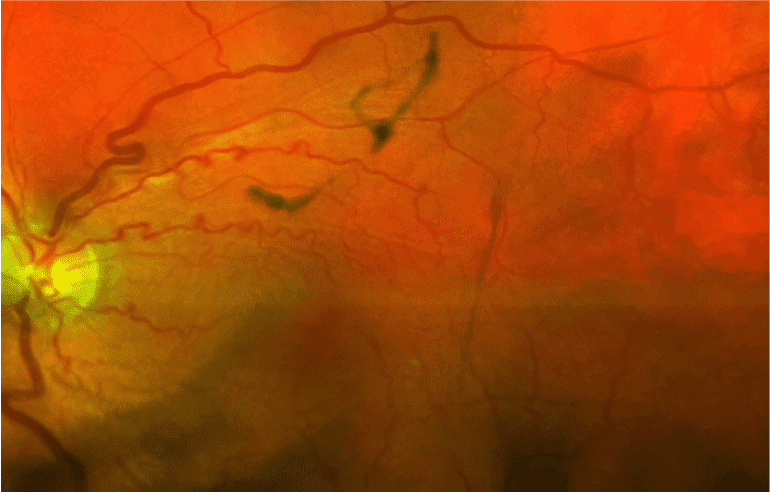Retina / Vitreous Detachment (Floaters)
What are floaters, or myodesopsia?
Floaters in the eyes or myodesopsia, are small black specks that the patient sees moving around in their field of vision, primarily when they look at a plain background, such as a wall,
It is currently one of the most common retinal problems and reasons why people see ophthalmologists. Since it is so common, some people just accept this visual defect as a part of their life and learn to live with it.

Characteristics of floaters
To recognise whether you have floaters rather than some form of eye disease, you can look out for the following characteristics:
→ Myodesopsia move slowly when the patient looks in one place. They never stay still.
→ They also follow the movement of your eyes.
→ If you look at a bright uniform area (the sky, a computer screen, etc.), they will be more visible.
→ They are more common in elderly and myopic people with a high prescription (myopia magna).
→ They may appear at times of stress or excessive fatigue.
Causes of floaters
Floaters in the eye are small gelatinous condensations that form in the vitreous humour (transparent liquid that fills the eyeball).
As such, although they appear to be in front of you, myodesopsia are actually floating in the vitreous humour and what we are actually seeing is shadows that these floating bodies project onto the retina.
They are usually a direct consequence of natural dehydration suffered by the vitreous. It is generally something that happens as part of the eye’s natural aging process. So, when might they appear?
→ In patients who have recently undergone cataract surgery, or a capsulotomy procedure, where the posterior capsule of the eye is cleaned with laser beams.
→ In patients with myopia.
→ In patients suffering from retinal detachment.
→ In patients suffering from an eye disease resulting from inflammation (uveitis), haemorrhages (vitreous haemorrhages of various kinds) or tumours (intraocular neoplasms).
→ Vitreous detachment: acute appearance of floaters in the eyes. Myodesopsia that appear suddenly or that are accompanied by flashes of light in your vision (photopsia) may be a serious warning sign of a tear to the retina.
Symptoms of floaters
Floaters in the eyes appear as follows:
→ Moving blotches, dots or filaments like dark specs or transparent threads in your field of vision.
→ Blotches that appear to flee your field of vision when you try to look at them directly. They move slowly.
→ They do not follow the movement of your eyes exactly.
→ Specks that may settle and often disappear from your field of vision.
→ Spots that you can see more clearly when you look at a background that is light in colour, evenly lit or with a lot of background light, such as a computer screen, a book or the sky, for example.

Simulated vision of floaters or myodesopsia
Treating floaters
Myodesopsia cannot be cured. There is currently no specific medical treatment for removing floaters.
When their vision is not compromised, the patient may just learn to live with the symptoms and their brain will just ignore them.
However, in exceptional cases, where these flashes of light interfere significantly with the patient’s vision, the ophthalmologist may consider the following treatments:
Vitrectomy
Vitrectomy is a surgical procedure that involves removing the vitreous humour and all the opaque elements contained within.
Vitrectomy is a very effective intraocular surgical procedure for retinal and vitreous disease that is performed under local anaesthetic with sutures. It is only intended for extreme cases where the symptoms are very incapacitating for the patient.
Preventing floaters
When a patient begins seeing floaters in their eye, it is normal to feel slightly bothered and stressed by them, but as long as they don’t compromise the quality of their vision, over time they will get used to them and learn to live with them.
If a patient’s vision becomes very blurry and their day-to-day life is affected, we recommend seeing a retina and vitreous ophthalmology specialist as soon as possible, so they can determine the causes of their appearance with the relevant tests.
As such, it is important to identify the issue early if you notice the following:
→ You have more floaters in your eye than normal.
→ There are flashes of light in your eye in the same place as the floaters.
→ Darkness caused by loss of vision in your periphery.
As explained above, floaters usually appear as a result of dehydration in the vitreous humour, leading to a clot-like substance forming inside that floats around in the gelatinous liquid, mimicking the appearance of a fly.
That is why it is important to keep your body hydrated by drinking enough fluids during and in between meals.
To prevent this dehydration, you should also avoid prolonged exposure to sunlight as UV-A rays may cause the hyaluronic acid to degenerate and accelerate cellular aging.
It is also important to include plenty of fruits and vegetables in your diet that contain a wide variety of minerals and vitamins to ensure the retinal layer in your eyes functions correctly.
→ To protect your vitreous humour, take antioxidants such as zinc, magnesium or vitamins A and B.
→ To protect your retina and crystalline lens from the sun, consume vegetables and fruits, particularly those containing lutein.



